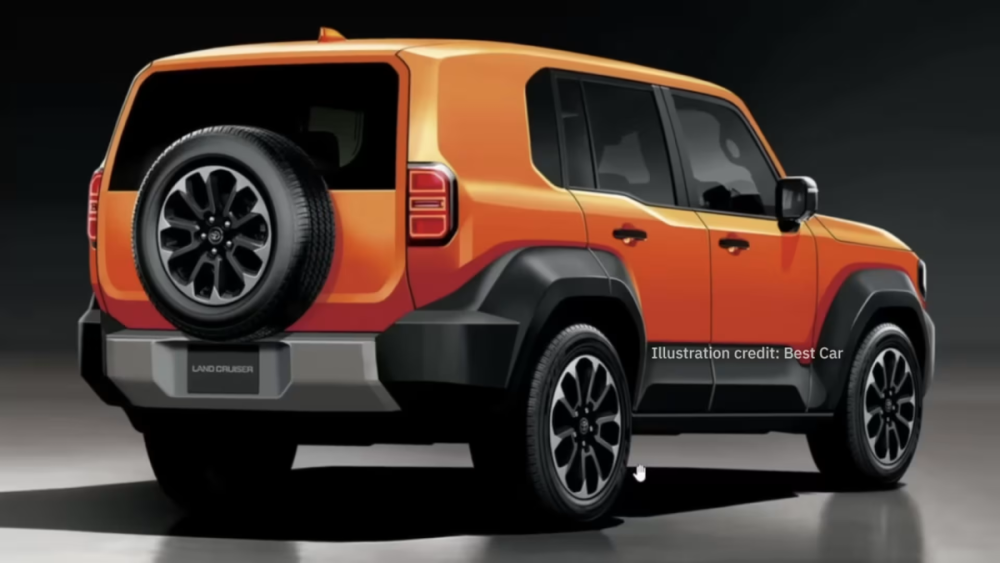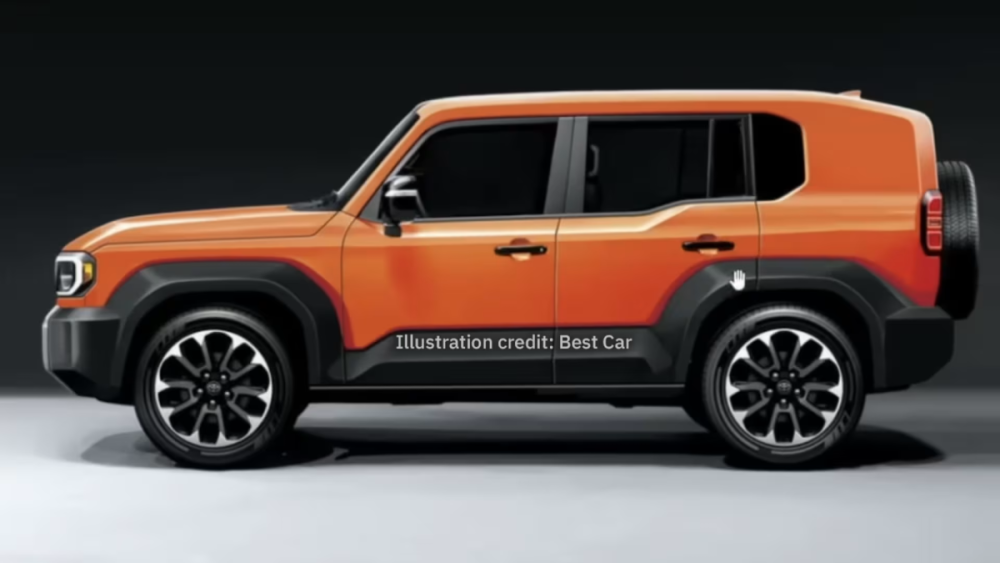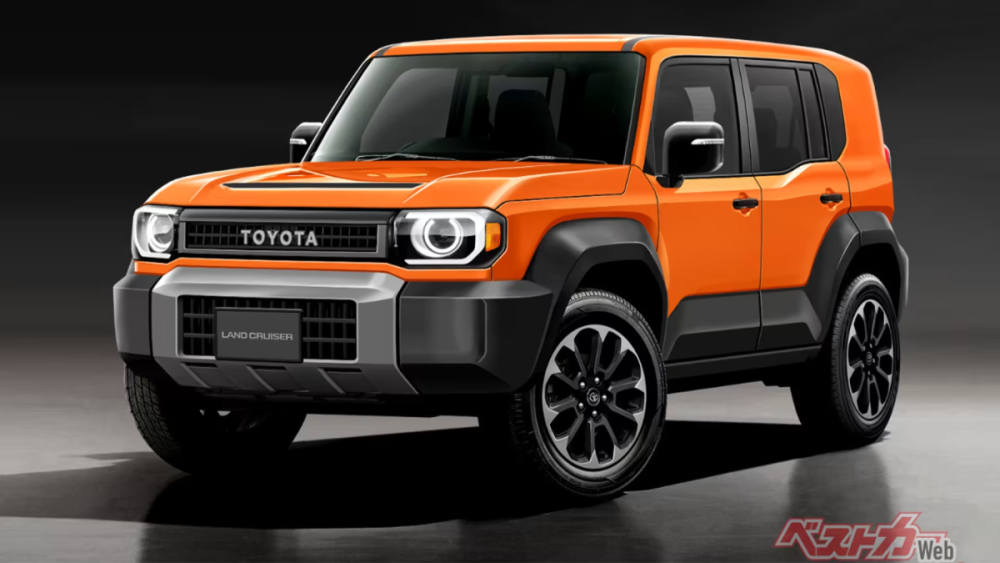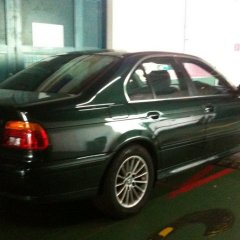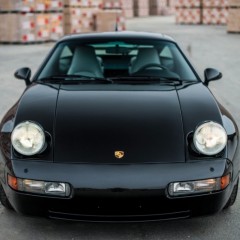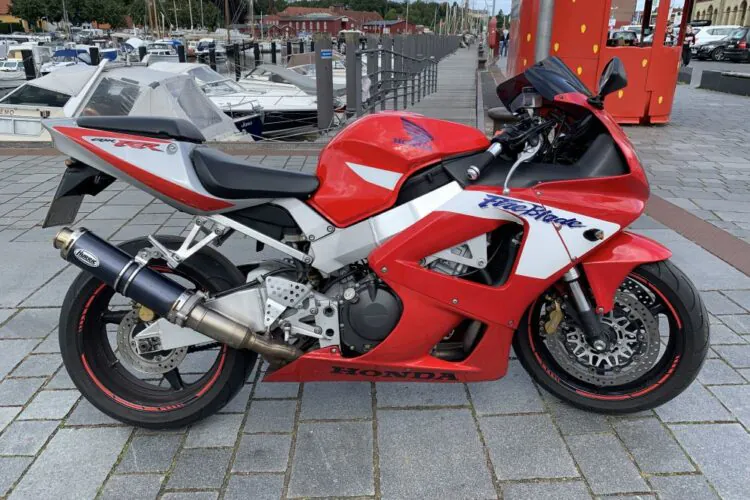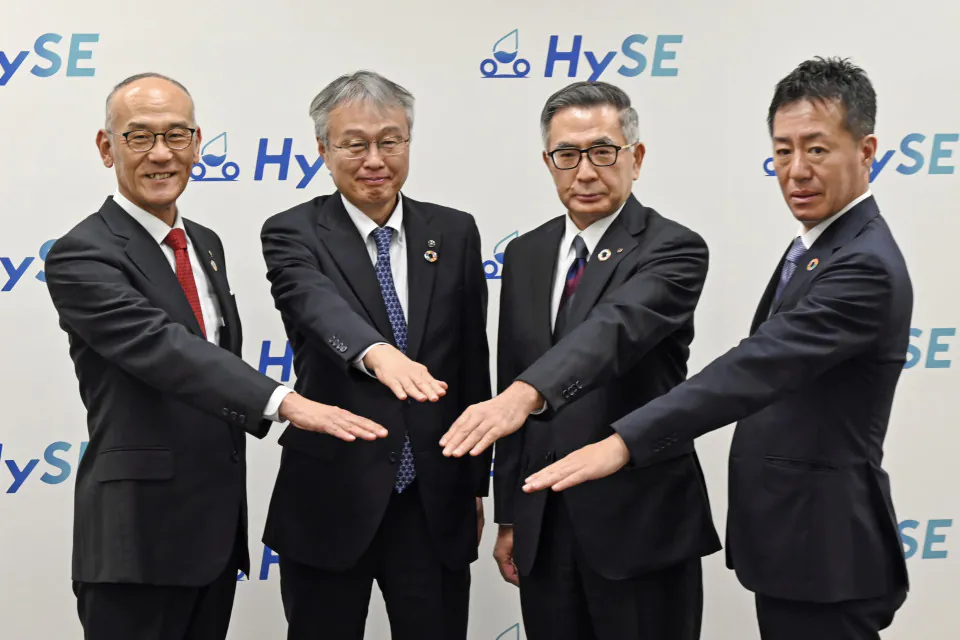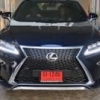Search the Community
Showing results for tags 'Toyota'.
-
Hi All, Seeking advise from those who had made purchases with a reliable PI and happy with their them (services, prices, etc.) We all have heard of one way or another of horrid experiences with PIs, but I am also sure there are genuine guys who are pleasant to deal with. Any recommendations from personal journeys? Also, other than the peace-of-mind distributorship between AD and non-AD and clearly price differential, are there any things to watch out for/differences between an AD and non-AD car, specifically for the Toyota Camry? Thanks.
-
Just sharing since Toyota is highly likely to release this in 2024, but whether it's PI or AD, remains to be seen.. The final name could be FJ or something else https://www.drive.com.au/news/details-leak-of-miniature-toyota-landcruiser-fj-a-suzuki-jimny-xl-rival/ "This suggests that the LandCruiser FJ will use the same Toyota iMV ladder-frame underpinnings as the Champ, albeit with a four-wheel-drive transfer case as opposed to the Champ’s rear-drive platform. With a wheelbase of between 2745mm and 2750mm (depending on application) the Toyota platform is longer than the new five-door Suzuki Jimny XL at 2590mm." This could very well be my next car.. Always wanted a SUV and something reliable but fun for my next one, that can carry people and has a higher hip point and is still funky, whilst being well built. Can't wait
-
-
Source: https://www.motor1.com/news/706112/toyota-gr-yaris-rz-sebastien-ogier-kalle-rovanpera-edition/ Almost a year to the day, Toyota announced two GR Yaris "concepts" at the 2023 Tokyo Auto Salon. They were the GR Yaris RZ Kalle Rovanpera and Sebastien Ogier Editions, wearing special appearance packages and tuned with bespoke drive modes befitting the WRC drivers for which they're named. The concepts came with a promise that, eventually, folks could buy one. That time has finally come. In the year that's passed since the debut, the GR Yaris received a big facelift. So the new models look a bit different. The core elements are the same though; Ogier's car is finished in a dark shade called Matte Stealth Gray, which helps accentuate the blue brake calipers behind those sharp 18-inch BBS wheels. A special rally spoiler made from carbon fiber reinforced plastic adorns the hatch, and you'll find a few decals honoring Ogier's WRC success and his home country of France. Rovanpera's car is brighter, wearing a version of his three-tone racing livery with special logos and WRC accolades. The rear wing is identical to that on the GRMN Yaris. Moving inside, both cars have special badging and contrast stitching unique to each edition. You'll also find exclusive full TFT gauge displays that show specific drive modes for each car. But the modes are far different than the gravel and track settings you'd find on a normal GR Yaris. The Ogier Edition gains Morzio Mode, which Toyota describes as "restraint (direct connection) maximally applied to the front and rear wheels during acceleration and relaxed only as necessary during braking." You also get SEB Mode, named for Ogier and tuned to send more power to the rear wheels versus the As for the colorful Rovanpera Edition, it gains a colorfully named Donut Mode which ensures "slide control during drifting." That sounds like a drift mode to us. There's also the KALLE Mode, which incorporates a different rear differential for "aggressively swinging out the vehicle's rear when entering a curve and pulling forward the vehicle's front using the accelerator." That also sounds like a drift mode to us, but one with a bit more emphasis on getting very sideways. Obviously, these special editions won't head to America, as the GR Yaris isn't sold here. Toyota will build just 200 total – 100 each – and you'll have to participate in a lottery starting in the spring for the chance to buy one. So the odds of seeing them anywhere will be very slim. Should you be chosen, you'll get the car and some neat VIP perks like meeting the drivers. There's no mention of price, though we suspect these cars will be a bit more expensive than your average GR Yaris.
-
https://www.cnn.com/2023/12/27/business/daihatsu-japan-production-halt-safety-tests-intl-hnk/index.html “The scandal is another blow to the automaker, which had admitted in April to violating standards on crash tests on more than 88,000 cars, mostly sold under the Toyota brand in countries such as Malaysia and Thailand.” This means many Thai-made Toyotas imported into Singapore also affected.
-
Source: https://insideevs.com/news/694239/toyota-cuts-ev-sales-expectations-record-profit/ Toyota Motor Corp. lowered its electric vehicle sales expectations for this fiscal year by a rather significant 39 percent, from an initial 202,000 units to a less-than-stellar figure of 123,000, the company said in its second-quarter financial report. However, let’s not forget that the Japanese company is one of the three biggest carmakers in the world and that its EV portfolio is pretty sparse, at least at the moment, so it’s no surprise that Toyota is leaning on its internal combustion and hybrid models to help it reach record profits by the end of this fiscal year that closes on March 31, 2024. Previously, the Japanese group predicted that its operating profit would match a record-high level of 3 trillion yen ($20.1 billion), but with the latest financial report, that prediction has gone up to 4.5 trillion yen ($30.15 billion). Until the fiscal year ends, Toyota wants to sell 3.6 million traditional hybrids worldwide, up from an earlier outlook of 3.5 million, while total electrified vehicle sales – including EVs, hybrids, plug-in hybrids, and hydrogen fuel cell vehicles – are expected to reach 3.9 million, up 42 percent from the previous fiscal year. Electrified vehicles will account for about 37 percent of the carmaker’s total sales. In total, the Toyota and Lexus marques are expected to manufacture a record 10.1 million vehicles this fiscal year, while the outlook for consolidated global retail sales has gone up to a record 11.38 million units in the current fiscal year. In the last fiscal quarter, Toyota registered a pretty rare double-digit operating profit margin of 12.6 percent worldwide, more than double the year before when it had a margin of 6.1 percent.
-
Source: https://uk.motor1.com/news/692411/toyota-direct-automatic-transmission-anticipates-shifts/ In 2023, automakers are eager to talk about that hot-new electric motor or battery pack that will be going into the next-generation EVs. Toyota is also dead set on electrifying its lineup from top to bottom, but it believes the transition shouldn't be rushed. In the meantime, it's still working on new hardware intended for cars with internal combustion engines. It's a sign the Japanese brand believes the ol' ICE isn't on its deathbed just yet. After Toyota chairman Akio Toyoda referred to the upcoming Direct Automatic Transmission as being a game changer, Japanese racing driver Hiroaki Ishiura is also praising DAT. He tested a GR Yaris with the new slushbox and is confident it's faster than a manual, so much so you won't be losing any time while going through the gears on a race track. Speaking for the official Toyota Times magazine, Hiroaki Ishiura added: "It locks in from the moment you set off, responding linearly to gas pedal input and allowing you to shave time off your laps without any loss. DAT senses when you're braking fully and downshifts for you to prepare for the next acceleration. It anticipates the actions ahead, just as we normally do when driving." Toyota says it has been working on this new gearbox since the second half of 2020. Although it's only been tested in motorsport so far, reports from Japan state the GR Yaris will get an eight-speed, torque-converter automatic in 2024. For now, the official word is that DAT is being developed to encourage more people to get into motorsport by making it easier to race after removing the clutch pedal. Hiroaki Ishiura says a conventional automatic transmission "feels slippery" and provides "little sense of a direct connection" whereas DAT mimics the behaviour of a driver that rows their own gears. The engineering team came up with the idea of a faster automatic after Akio Toyoda said he wanted "to spread the joy of driving" because not a lot of people know how to drive a manual.
-
This thread is set up for discussions on anything technical, features or use relating to Toyota Safety Sense 3.0 as well as Driving Assists which have become mainstream. Version 2.5 and 2.5+ are also welcome. Where possible, please indicate car/model as well as version for ease of discussion. Also include the acronyms like PCS, DRCC, AEB, ESA, RSA, LTA, VSC, TRC, etc. It is not for the discussion on the price or cost related issues, and comparison with other makes/models and similar irrelevances.
- 40 replies
-
- 1
-

-
- toyota
- safety sense
-
(and 2 more)
Tagged with:
-
This thread is set up for discussions on anything technical, features or functions for the 2023 Corolla Cross Hybrid 2.0 It is not for the discussion on the price or cost related issues, comparison with other makes/models and similar irrelevances.
- 52 replies
-
- 3
-

-
.png)
-
- toyota
- corolla cross
-
(and 1 more)
Tagged with:
-
Source: https://insideevs.com/news/685267/toyota-hilux-hydrogen-fuel-cell-prototype/ Toyota built its first Hilux Hydrogen Fuel Cell Prototype at its Burnaston vehicle plant in Derby, England. It is a joint project with consortium partners and was supported by UK government funding. The automaker intends to build 10 of them before the end of the year. This Hilux's powertrain uses parts from the Toyota Mirai. The automaker estimates that it has a range of 365 miles between hydrogen refills. For comparison, the Australian-market Hilux with the turbodiesel 2.8-liter engine can go about 715 miles (1,150 kilometers) between fill-ups. Images show that the hydrogen tanks fit between the frame rails roughly where the cabin fits. The other fuel cell components are under the hood, where the combustion engine usually is. The battery is at the rear. Toyota started this project in early 2022 as a feasibility study. Design and development began on July 1, 2022. The company started building a prototype on June 5, 2023. The automaker intends to put the 10 prototypes through testing to make sure the model lives up to the Hilux's rugged legacy. Toyota is prepping safety performance, functionality, and durability tests for them. The company wants to understand the opportunities and risks of a fuel-cell-powered pickup. In December 2022, Toyota showed off the electric Hilux Revo BEV Concept. The automaker didn't release any details about the truck at that time, like battery or motor specifications. During the presentation, Akio Toyoda said, "BEVs are not the only way to achieve the world’s carbon neutrality goals." Also in 2022, Toyota announced that it intended to build a light-duty pickup with a hydrogen fuel cell as a joint project with Isuzu and Hino. The company didn't specify a time frame for putting this model into production. Toyota is also considering whether to make a fuel-cell-powered version of the Land Cruiser. Plug-in hybrid and fully electric versions are also a possibility. At this point, it's not clear which, if any of these, would actually go into production.
-
After the Corolla Cross and new Crown, another iconic Toyota model has been SUV-nised... I seriously hope the trend will stop soon. @Toeknee_33what's your thought? Toyota announced the debut of an all-new model on September 6, which will be streamed live on YouTube from Tokyo, Japan. The automaker didn’t name the model but the official teaser photos showing portions of the front and rear suggest it will be the already-confirmed Century-branded SUV. Stay tuned for more updates. 🙂
- 29 replies
-
- 13
-

-

-

2024 Toyota C-HR Debuts With PHEV Making 223 Horsepower
kobayashiGT replied to SGCM928's topic in Japanese Talk
Source: https://www.motor1.com/news/673692/2024-toyota-c-hr-revealed/ It was December 2022 when Toyota previewed the second-generation C-HR by releasing the Prologue concept and now it's time to finally meet the subsequent production model. It adopts a substantially different design without losing the funkiness of its predecessor that has proven to be popular in the crowded small crossover segment. Its replacement has been developed and engineered in Europe where it's also going to be manufactured. We're being told the 2024 C-HR has a "super coupe" profile and gets 20-inch wheels as well as a two-tone paint job. Toyota went the extra mile to reduce the shut lines and better integrate the cameras, sensors, and headlight washers to give the body a smoother look for a cleaner design with improved aero. In terms of dimensions, the new model is 4360 millimeters (171.6 inches) long, 1830 mm (72 in) wide, and either 1558 mm (61.3 in) or 1564 mm (61.5 in) tall depending on the version. Step inside the cabin with its 2640 mm (104 in) wheelbase and you'll notice a 12.3-inch fully digital instrument cluster joined by a touchscreen of the same size. Fancier versions also get a head-up display, 64-color ambient lighting, a panoramic roof, and a JBL sound system. Unlike other brands, Toyota is not ready to give up on buttons for often-used functions, even though screens keep getting bigger with each generation of a new car. Red accents and a GR badge belong to a new GR Sport Premiere Edition with sporty touches inside and out. As expected, the new C-HR will be available in Europe exclusively with hybrid power. The 1.8-liter unit and the 2.0-liter plug-in hybrid setup come only in front-wheel-drive guise while the 2.0-liter hybrid can be had with optional AWD. In terms of power, the base 1.8-liter unit delivers a combined output of 140 hp (103 kW), followed by the 2.0-liter setup with 198 hp (145 kW), and the PHEV with 223 hp (164 kW). In terms of performance, the entry-level model with the 1.8-liter hybrid powertrain does 0 to 62 mph (100 km/h) in 9.9 seconds and tops out at 106 mph (170 km/h). The FWD 2.0-liter model takes 8.1 seconds to complete the sprint, or 7.9 seconds if you step up to the AWD variant. Both these 2.0-liter hybrid models can do 112 mph (180 km/h). As for the PHEV, it completes the sprint in 7.4 seconds and can do 112 mph (180 km/h). With the battery charged, you'll be able to cover 41 miles (66 kilometers) on electric power. Toyota is already taking online reservations in Europe where the GR Sport Premiere Edition we mentioned earlier is joined by a High Premiere Edition with its own subset of features typically found on the high-end versions. While the first-generation model was sold in the United States, its successor won't be offered there. -
The MPV look gigantic in size (5 mm shy of 5 m from end to end), and finally available in 2.4L Turbo, producing a healthy 275 horsepower and 430 NM. Toyota has unveiled the fourth-generation Alphard alongside the Vellfire. These follow the recently introduced posh Lexus LM, a mechanically related vehicle based on the same TNGA-K platform. The twin are the first Toyota models to have steps on both left and right sliding doors, with a step emerging about 220 millimeters above ground. The boxy minivans are 4995 mm long and share a massive wheelbase stretching at 3000 mm. Both are 1850 mm wide while height depends on the model and trim level, either 1935 mm or 1945 mm. The Alphard and Vellfire can seat up to six people in a 2+2+2 layout with second-row captain's chairs. There's now an extra 5 mm between the first two rows and an additional 10 mm between the second and third rows. Both can be had with front- or all-wheel drive as well as a hybrid powertrain, with a plug-in hybrid setup to be added later. The most powerful of the bunch is a turbocharged 2.4-liter, four-cylinder engine available in the Vellfire. "Tuned to deliver a sporty sound," it makes 275 hp (205 kilowatts) and 430 Newton-meters of torque. Customers can also pick a hybrid based on a 2.5-liter gasoline engine with a combined output of 250 hp (184 kW). Lesser Alphard models have a non-electrified, naturally aspirated 2.5-liter, four-cylinder unit with 180 hp (134 kW) and 235 NM. Depending on the engine, the minivans come with a CVT, an e-CVT, or an eight-speed automatic.
- 23 replies
-
- 12
-

-
Got money but no manners. Or basic human decency. Watch the video to see why. What happened? On 10 June, last Saturday at the Johor-Singapore Causeway, a Malaysian Toyota Alphard decided that it would be better to risk going to jail and injuring a traffic marshal instead of facing the consequences. The Toyota was seen driving on the bus-lorry lane. This is seen as soon after it passes by the camcar on screen, a bus appears behind the Alphard. This did not go unnoticed by traffic marshals either, who were shown telling the Toyota to turn around and go to the start of the queue. Making a move to go to the right, the Toyota made a feint as if to comply before righting itself and going full speed ahead, before the officers could do something. If the officers made a move to block the Alphard from continuing straight, it is likely injuries would have occurred. Online chatter Many are angry that the Toyota driver can behave in such a manner, and call for punishments such as jail or being banned from entering Singapore again. Others are resigned, saying that the driver can simply come back to Singapore with new plates and get away scot-free. Punishment? The comments about swapping plates intrigued me. So I did some research about what measures are there to find this person again. If you don’t know, when travelling by car on the Causeway you need a Vehicle Entry Permit (VEP)/ Autopass card. This card would require your registration with your passport or identification card. So in theory, even if the driver comes back with a different number plate, the authorities can still catch them by looking at the current name attached to the current number plate and blacklist it! This way, the driver will be caught on their next attempt to come to Singapore. Here’s to hoping the law prevails. ========= Be the first to get the latest road/ COE news and get first dibs on exclusive promos and giveaways in our Telegram SGCM Community. Join us today!
- 4 comments
-
Basically a Toyota Yaris Cross in a tuxedo. Rumors of a fancier Yaris Cross have been swirling around for years and now the Lexus LBX is officially here. Positioned below the UX and serving as the new entry-level model, the tiny crossover is an indirect replacement for the defunct CT hatchback. It rides on the same GA-B platform as its Toyota sibling but with different styling to better fit Lexus' design language both inside and out. The LBX is 4,190 millimeters long, 1,825 mm wide, and 1,545 mm tall, while having a wheelbase of 2,580 mm. Riding on 18-inch wheels as standard equipment, the petite Lexus is actually slightly bigger than the Yaris Cross and tips the scales at 1,280 kilograms. It will be offered with a choice between front- and all-wheel drive, with all configurations coming exclusively with a continuously variable transmission. At the heart of the LBX is a hybrid powertrain based around a three-cylinder, 1.5-liter gasoline engine. It produces a combined output of 134 horsepower (100 kilowatts - just nice in cat A) and a maximum torque of 185 Newton-meters. It's enough electrified punch for a 0 to 100 km/h run in 9.2 seconds and a maximum towing capacity of 750 kilograms. All versions of the latest Lexus get a MacPherson strut front suspension while the rear uses a torsion beam for the FWD models and a double wishbone if you opt for AWD. Although the technical specifications for the latter have yet to be disclosed but it will add an electric motor at the rear. Interestingly, the small crossover has an aluminum hood as well as molded resin wheel arches, rockers, and lower door sections to keep weight down. Stepping inside, the LBX boasts a 12.3-inch fully digital instrument cluster with an optional head-up display joined by a 9.8-inch touchscreen. The infotainment supports both Apple CarPlay and Android Auto, but only the former has wireless connectivity. Lexus has once again teamed up with Mark Levinson, which supplies the 13-speaker sound system that comes along with a subwoofer. Stick to the front-wheel-drive model and you get a cargo capacity of 332 liters with the rear seats in place. The AWD-equipped LBX is likely to be less practical due to the extra hardware installed at the back. Lexus mentions it hasn't made any compromises in terms of quality and attention even though this is the new entry-level model. The LBX is the company's first model for which development primarily took place in Europe. It's scheduled to enter production by the end of this year and go on sale in Europe along with additional markets in early 2024.
- 46 replies
-
- 13
-

-
.png)
-
The upcoming national car of Singapore, brought to you by Grab, Gojek, Ryde, Tada, GetGo, Tribecar, etc. 🙃 Toyota’s prototype for the upcoming new C-HR has been spied testing ahead of an expected launch in late 2023 https://www.autodaily.com.au/2024-toyota-c-hr-spied-for-the-first-time/ Due on sale by 2024, the Mk2 C-HR will be a close sibling to the new Toyota Prius, underpinned by the same TNGA platform and offered with the same mix of parallel-hybrid and plug-in hybrid powertrains. The latter will be a variation of the Prius’s PHEV set-up, pairing a 110kW 2.0-litre four-cylinder petrol engine with a 118kW electric motor on the front axle for a combined 165kW. That’s a 30kW boost over the current (2.0-litre parallel-hybrid) C-HR. Should the C-HR also borrow the Prius’s 13.6kWh battery (a likelihood to exploit economies of scale and cut costs), an 80km electric-only range may be within reach. Alongside the technical reinvention, the C-HR will be restyled with a focus on the new-look ‘Hammerhead’ front-end design being rolled out across the line-up to give Toyota cars a common identity. Camouflage hides just how closely related to the concept the production car will be, but clearly the distinctive C-shaped headlights and wraparound rear light bar will make it through to showrooms. The C-HR may also gain a battery-electric variant, placing it directly in competition with the triple-powertrain Niro. Spy photographer claimed this test car is a pure-EV proposition, suggesting Toyota’s Small SU EV concept from 2021 – itself almost identical to the more recent C-HR concept – is nearing fruition. Toyota hasn’t confirmed whether an electric C-HR is in the works and wasn’t available to comment on these latest images, but the fundamental similarities between the C-HR’s TNGA platform and the EV-only E-TNGA architecture mean it would no doubt be a technical feasibility. An electric version of the C-HR would be positioned below a larger electric coupé-SUV, known at concept stage as the bZ Compact Crossover concept, which will itself sit underneath today’s bZ4X in an expanded Toyota SUV line-up.
-
TLDR - The meme before the video starts This situation is just free entertainment for the camcar. The meme below sums up all you need to know honestly. What happened? A Toyota MPV driver on the causeway decided to start a fight with a Honda Vezel. We don’t have any context to this as the video starts here, but I assume it’s because the Vezel is trying to cut the queue and go first. The Toyota driver got out and kicked the Vezel in the side. That kick had some oomph to it. Some words were exchanged when the passenger of the Vezel decides to step out in the driver’s place. Reminds me of Jojo stands, or sending your Pokemon out to do battle. The two men proceed to argue, with the Toyota driver gesturing to his vehicle. I assume this is to point out his car is in front. You might be thinking this is obvious, but the Vezel driver sure doesn’t think so. Both sides have raised hands. There’s a lot of pointing and pushing around before the Toyota driver eventually concedes and goes back into his car before driving off. The Vezel passenger lingers and waits for him to leave before going back into the car, as if expecting a sudden comeback. And finally the queue moves again. It’s a shame there’s no audio. Online chatter Some people criticised not the fact that the argument happened, but that it didn’t escalate to blows being exchanged. Two others noted the Toyota driver starting it by kicking the Honda. Humans are dark… Others made jokes about how they look like they were going to kiss, or how the Vezel driver sent to passenger out to find in their stead (John Wick 4, IYKYK) ========= Be the first to get the latest road/ COE news and get first dibs on exclusive promos and giveaways in our Telegram SGCM Community. Join us today!
-
Source: https://www.lowyat.net/2023/300587/japanese-brands-hydrogen-bike-engines/ Specifically Honda, Suzuki, Kawasaki and Yamaha, with Toyota being a "special member". When it comes to clean alternatives to fuel, much of the conversation is centred around electric vehicles (EVs). Every once in awhile, hydrogen engines come up, but these are usually talked about with regards to cars or larger vehicles. Four Japanese bike makers are looking to change that, as they have announced a research partnership for developing hydrogen-powered combustion engines for motorcycles. The research group is collectively known as the Hydrogen Small Mobility & Engine Technology (HySE), comprising of Honda, Suzuki, Kawasaki and Yamaha. Beyond the four, Kawasaki Heavy Industries and Toyota are also included as special members of the association, which has been granted approval by the Japanese Ministry of Economy, Trade and Industry. Each of the four companies also have their roles within HySE quite clearly defined. As per the press release by Honda, the company will be responsible for “research on the model-based development of hydrogen-powered engines”. Suzuki, on the other hand, will be working on “element study on functionality, performance, and reliability” instead. Yamaha will be working on the tank and refueling systems, while Kawasaki handles the auxiliary equipment for the tank and fuel supply system, as well as the equipment in between the fuel tank and injector. Both of these companies will also be doing “hands-on research using real hydrogen-powered engines on their functionality, performance and reliability”. Among the challenges faced by those looking to make hydrogen engines for bikes is due to the fact that they are smaller, and therefore have more limited room for hydrogen fuel cell storage. Japanese online publication Kyodo News also reports that HySE is also considering installing these engines onto boats and even drones, should this research in making hydrogen engines for bikes be successful. The report also notes that while members of the association are working together for the research, the decision to make anything to be sold commercially is up to each company.
-

Cambike screams CB after near-miss with blind Toyota PHV driver
Fadevfast posted a blog entry in MyAutoBlog
As expensive as cars are nowadays, I doubt this driver has enough money to get away from the consequences if this almost turned into a snuff film. What happened? On the Pan-Island Expressway (PIE) a cambike was just minding its own business when a Toyota Sienta forced its way through on the same lane. You can hear the cambike swear at the car after the near miss. I would too if I almost died like that. Unfortunately, it also seems that the penalty for vehicular manslaughter is surprisingly low. Motorists caught causing death performing a negligent act may be punished with imprisonment for no longer than 5 years, or with a fine or with both. It is also not guaranteed to ban the offender from driving for life, and can instead be reduced to a period of time as the court sees fit. Online chatter. The driver was of course criticised for his dangerous driving. The car being under the Private Hire scheme didn’t help and added to the driver’s ridicule (and the bad rep of PHV drivers). Someone in the comments had an interesting plan to get an insurance claim and commit insurance fraud. ========= Be the first to get the latest road/ COE news and get first dibs on exclusive promos and giveaways in our Telegram SGCM Community. Join us today! -

An Early Look at the 2023 Toyota Prius Prime XSE Premium
kobayashiGT posted a topic in Japanese Talk
Source: https://hypebeast.com/2023/4/toyota-prius-prime-xse-2023-early-look Toyota has just revealed its latest Prius Prime model for 2023 and, with its clear restyling and hybrid performance improvements from the previous generation, it could be the new choice for the discerning car consumer in a “sea of electricity.” The all-new Prius – which was announced earlier this year – arrived with fanfare around its substantially new design, and the Prime maximizes itself in the looks department. To summarize, the Prius Prime is sleek, with a radically raked front windshield that’s more “sports coupe” than “efficient city car.” A sloping rear roof that drops off suddenly at the hatch lip gives an almost boxy-yet-futuristic angle to the rear, while a flat rear bumper complements the front’s near-90º angled fascia. Speaking of the rear, the Prime is actually wider than the previous generation, which is a bold move from Toyota since a wider stance would actually harm efficiency. More on that and these decisions later. The Prime XSE Premium is also equipped with 19” machine-finished wheels that sit two inches lower than the previous generation. This stance and the large wheels give the appearance of aggression and again goes against the grain of efficiency, yet works well with the Prius Prime’s appeal. Sharp angular LED headlights, a low and pronounced front air dam, rear LED light bar and rear door handles at the C-pillar are other visual choices that make the new Prius Prime stand out. Inside, the cabin feels more refined and evolutionary, with driver-passenger enhancements to touch points and visuals being the main takeaway. Dashes of red – at the dashboard, shifter and even on the seats – adorned our test car’s interior that gave the rather-boring black upholstery a much needed pop. We also liked the dual digital screens, acting as the gauge cluster and infotainment center. Bonus points for all the climate controls being accessible through knobs and buttons rather than within menus, and for the volume knob too although it was a bit far for the driver to reach. The most surprising element within the cabin was the steering wheel, which felt small in hand, giving the impression that whoever designed it had handling and dare-we-say “sportiness” in mind. Performance-wise, the Prius isn’t a sports car, but has shown improvement over the last gen. Inside are two motors: a 2.0L gas-powered engine good for 150 horsepower, and a 161 hp electric motor working in conjunction. The net total of both comes to 220 hp and 139 lb-ft of torque that allows the Prius Prime to accelerate from 0-60 in 6.6 seconds – the previous Prius was up in the sevens. While not sports car territory, acceleration in six seconds is competitive against the Audi A3 e-tron Sportback at 6.5s, the BMW i3 at 6.6s and even the turbo-four cylinder Mercedes-Benz GLA 250 at 6.5s. Overall the car felt zippy when it needed to be and the power should be more than enough for most people, but certainly not for the enthusiasts. So why did Toyota create a new Prius with big wheels, a wider body and a lower stance, all of which go against the ideals of maximum efficiency? For once, the hybrid Prius is a contender against the “new norm” of electric cars you see on the road. The Prius’s design alone adds a new layer for consumers in search of a car that looks great and drives well, even if it sacrifices a bit of efficiency. Back in the early 2000s, most can remember looking at the Prius and scorning it for being bland and boring; for Toyota to flip that script and now be considered an alternative to a new defacto is invariably a bold statement, and that’s what makes the new Prius different, daring, and possibly even “cool.” The Toyota Prius Prime XSE Premium starts at $39,170 USD and begins shipping in May. If you’re looking for something from Toyota that’s no compromises, the GR Corolla is the latest in the sporty offerings department. -

Toyota Wish rocked back and forth by driver while being 'fed' petrol like a baby
Fadevfast posted a blog entry in MyAutoBlog
This Toyota Wish was treated better than I was when growing up. Watch the video to see why. What happened? At Gelang Patah R&R, a Toyota Wish was spotted being given some special treatment while refuelling. It was gently rocked by its driver and assisted by an attendant in a tender effort to quench the car’s thirst for fuel. I’m jealous. Why couldn’t my parents treat me this way? Looking at this did make me curious though. Does shaking the car do anything at all? Short answer: No. Nope. First, your car has a fixed capacity fuel tank (duh), if it is not fixed and can somehow fill up indefinitely, please contact us at [email protected]. However, the theory is that when filling up petrol there are air pockets that form during the process. This reduces the amount of petrol that one can pump into their car, wasting time and money. Think of it like a soft drink can, where there’s always air in the can so the can is never truly full. However, rocking isn’t the way to solve this. In CNA’s Talking Point episode 32, the director of Mister Garage, Vincent Emmanuel Lee debunked this myth, saying “When we pump the petrol into the tank, it creates foam and vapour (which) occupies the tank. When we wait for the vapour and foam to dissipate, that's when you can pump more petrol into the tank.” This makes shaking ineffective as everything is already at the top instead of within the liquid. Online chatter Back to our usual Facebook clownery, people made fun of the shaking and rightfully deemed it useless. However, some people took offense to the footage being recorded in the first place, saying the person who took the footage had nothing better to do as the driver did nothing illegal. Writer’s thoughts: I was treated very well as a kid I just needed to get your attention for this article lol. ========= Be the first to get the latest road/ COE news and get first dibs on exclusive promos and giveaways in our Telegram SGCM Community. Join us today! -
Source: https://www.motor1.com/news/653238/nissan-says-rav4-hybrid-economy-unrealistic/ Automakers are not above taking shots at each other for performance claims like real-world fuel economy. Most recently, Nissan took aim at Toyota's RAV4 hybrid indicating the fuel economy ratings on the popular small SUV are exaggerated. Case in point, the Nissan X-Trail e-Power uses a gasoline engine to recharge the onboard lithium-ion battery and gets an estimated 6.1 liters per 100km, or about 38.6 mpg. By comparison, the Toyota RAV4 uses a conventional hybrid system that delivers an estimated 4.7 liters per 100 km, or the equivalent of 50 mpg, a fuel economy increase of about 30 percent. Nissan indicates that the fuel economy differences between the two vehicles are not as far apart as the estimates suggest and believe the real-world performance is closer. "I think with the fuel economy, it's a tricky one. We'll leave it in your hands to do the real-world testing. But from a lot of the articles I've seen for RAV4 Hybrid, you can't get anywhere near 4.8 (liters per hundred kilometers)," says Aleksandar Pecanac, Nissan Australia's product manager for X-Trail. Nissan goes on to claim that its X-Trail e-Power system delivers a superior driving experience. According to Adam Robertson, deputy director of the Nissan Technical Center in Europe, the X-Trail drives "More like an EV, and we know from our experience with EVs that customers love it." Robertson goes on to say, "EVs have the highest level of satisfaction for acceleration, and that's not just the outright performance for a car like the Porsche Taycan. That's all EVs. "We also know that traditional hybrids have the lowest satisfaction. We wanted to capture the customer experience that they really like and bring that in with e-Power." The Nissan X-Trail e-Power launched last fall in Japan and Europe as an electrified version of the Rogue. The automaker has not yet indicated if and when it will bring the e-Power version of the Nissan Rogue to the US. Currently, Nissan's US website only mentions the e-Power on the Nissan Leaf.
-
https://asia.nikkei.com/Business/Automobiles/Toyota-to-develop-new-Lexus-EV-for-2026-incoming-president?utm_campaign=GL_JP_update&utm_medium=email&utm_source=NA_newsletter&utm_content=article_link&del_type=4&pub_date=20230214085958&seq_num=3&si=44594 Toyota to develop new Lexus EV for 2026: incoming president Koji Sato says company will first focus on making such cars for high-end market Toyota's first electric Lexus, the RZ, will be launched this year. (Photo by Hirofumi Yamamoto) SAYUMI TAKE, Nikkei staff writerFebruary 13, 2023 20:19 JST TOKYO -- Japanese automaker Toyota plans to develop a "next-generation" all-electric Lexus model by 2026 to meet rising demand for such luxury cars, according to the company's incoming president. "We aim to develop a next-generation battery EV in the Lexus brand in which everything from batteries and platforms to the way the car is built will be optimized for BEVs," said Koji Sato. As current chief of the brand, he oversaw the development of the first electric Lexus, the RZ, which is expected to be launched this year. BEVs refer to all-electric vehicles that are generally called EVs by other automakers, but Toyota uses this name to distinguish them from the hybrid, plug-in hybrid and fuel-cell vehicles that it also makes. Sato, who will replace Akio Toyoda in April as the new president and CEO of Toyota, made a speech and answered reporters' questions at a news conference on Monday. He named seven others who will form the new management team with him and talked about his plan to transform Toyota from a carmaker to a mobility company. "To deliver appealing BEVs, we need to drastically change the way we do business, from manufacturing to sales and service, with a BEV-first mindset," Sato said. "Lexus will lead this transformation." Koji Sato will take over as president of Toyota in April. (Screenshot from Toyota Motor's YouTube page) He pointed to the EV shift in developed countries, which is the main market for the Lexus brand, and said that Toyota is trying to meet such rising needs. Sato, a veteran Toyota engineer, said that electricity has "a different influence on aerodynamics... We have to sufficiently understand the characteristics of electricity... and take a step further and manufacture [the cars] in the best suited way." Toyota has faced criticism from environmentalists and investors for failing to catch up with its peers in the development of EVs. Sato pointed out that the emphasis on the electrification of Lexus was part of Toyota's goal to provide a range of vehicles that can meet demand from all buyers. "The energy situation is different in each country, and Toyota's unchanging policy is to consider the circumstances of each country," he said. Asked about concerns over Toyota's EV strategy, Sato said he regretted that there were "communication issues" around the matter. Toyota's EV strategy is for the mid to long term and it is currently focused on energy-saving efforts and cutting emissions from its models by using hydrogen fuel-cells and other technologies in addition to batteries, as well as in its day-to-day business operations.
-
https://asia.nikkei.com/Business/Automobiles/Tesla-earns-5-times-more-per-car-than-Toyota-earnings-show?utm_campaign=GL_JP_update&utm_medium=email&utm_source=NA_newsletter&utm_content=article_link&del_type=4&pub_date=20230210085958&seq_num=6&si=44594 Tesla earns 5 times more per car than Toyota, earnings show EV maker catching up to Japan's top automaker in net profit Tesla electric vehicles at a sales and service center in California. The U.S. EV maker has a limited lineup of just four high-end models. © Reuters KEI MIYATA and YUKI FUKUMOTO, Nikkei staff writersFebruary 10, 2023 05:20 JST NAGOYA, Japan -- Toyota Motor earned less than a fifth in per-vehicle earnings compared with Tesla during the April-December period as Japan's giant automaker struggles to absorb rising costs. Toyota earned 240,000 yen ($1,820) in net profit per unit during that time span last year. In contrast, Tesla raked in the equivalent of 1.26 million yen per vehicle during the same period. This discrepancy shows the limits of Toyota's "multi-solution" strategy that puts out gasoline vehicles alongside fuel cell and electric vehicles. The wide-ranging approach has exposed Toyota to a costlier business environment while Tesla has remained more insulated by its EV-focused lineup. During the nine months ended December 2022, Toyota's raw material costs increased 1.1 trillion yen compared with a year earlier. Toyota expects 210 billion yen in groupwide cost savings for the financial year ending March, but that number falls well short of offsetting the extra costs. The trend is particularly conspicuous in Toyota's North American operations, where it is normally easier to pass on higher costs to sticker prices compared with Japan. In the three quarters through December, Toyota earned 49.2 billion yen in operating profit in North America, a decline of roughly 450 billion yen from the year-earlier period. The company suffered an operating loss in that region during the October-December quarter. "The price hikes on vehicles haven't kept up" with increased material costs, said a manager. In Japan, an executive at a parts supplier in Aichi prefecture that works with Toyota expressed a sense of relief despite facing rising fuel expenses. "It looks like Toyota will pay for 70%-80% of it," said the executive. Toyota has been partly covering energy bills and material costs for suppliers since summer last year. The parts supplier in Aichi has successfully negotiated a deal with Toyota in which the automaker will shoulder most of the extra fuel costs. "There's no other automaker that takes care of electricity and gas bills like Toyota," said a senior manager at another parts supplier. A Toyota dealership in Michigan. Toyota Motor's North American operation has been unable to cover cost increases through price hikes. © Reuters Globally, Toyota does business with roughly 400 first-tier suppliers alone. Covering fuel and material outlays for that number of suppliers is a highly cost intensive endeavor. Toyota looks to maintain its supply chain so that it can realize cost savings jointly with suppliers, though much of the scale comes from the fact that Toyota, the world's top-selling automaker, has adopted a strategy that spans roughly 50 models from gasoline vehicles to EVs. Because of that full-lineup business model, the higher costs have started to weigh on Toyota. The company's per-vehicle profit in April-December is down by 56,000 yen from a year earlier, while Tesla is up by the equivalent of 500,000 yen. Unlike Toyota's wide-ranging lineup, Tesla fields just four high-end models. Since 2021, Tesla has significantly expanded its production and sales volume, which improved the company's earning capacity. For the three quarters through December, Tesla earned the equivalent of 1.26 trillion yen in net profit, which is closing in on the 1.9 trillion yen Toyota generated during the same period. BYD, the Chinese maker of mass-market EVs, is earning between 190,000 yen to 200,000 yen per vehicle and is gaining on Toyota. Last year, BYD sold 1.86 million electrics, including plug-in hybrids, a volume that is up by a factor of 3.1. This momentum comes courtesy of BYD's vertical integration. The company manufactures automotive batteries in-house and controls a subsidiary that makes semiconductors. BYD is quickly expanding operations worldwide, the latest move being the launch of EV sales in Japan this January. Along with Tesla, BYD is steadily making a name for itself through its strong earning capacity. For Toyota to stage a comeback against the rivals, the company faces the immediate challenge of boosting production volume. Toyota plans to sell up to 10.6 million units this calendar year under the Toyota and Lexus brands. If Toyota achieves its production goals, it would be able to use its economy of scale to bring costs down while not missing out on sale opportunities. Raising prices on vehicles would likely become easier under this scenario. However, ramping up production is easier said than done. Toyota on Thursday said it plans to only make 9.1 million units this fiscal year, a downgrade of 100,000 units due to a semiconductor shortage. Toyota looks to respond by minimizing the number of semiconductors used per vehicle. For example, if each Lexus vehicle comes with just one keyless fob instead of two, that would free Toyota to manufacture roughly 100,000 extra vehicles. In addition, Toyota group company Aisin is redesigning transmissions and other components it produces. Aisin is adopting designs that can accommodate off-the-shelf semiconductors. This spring, Lexus will add the fully electric RZ to its lineup. Koji Sato, Toyota's incoming president, oversaw the development of the model. Toyota plans to expand its EV lineup, an approach that had been delayed by the company's multi-solution strategy.
-
https://asia.nikkei.com/Business/Automobiles/Toyota-targets-the-rich-with-new-Century-Lexus-models-in-Japan?del_type=4&pub_date=20230204090000&seq_num=3 Toyota targets the rich with new Century, Lexus models in Japan Automaker hopes to take on luxury heavyweights like Rolls-Royce and Bentley An SUV version of Toyota's Century luxury car will go on sale later this year. (Photo courtesy of Toyota) KAZUHIRO NOGUCHI, Nikkei staff writerFebruary 4, 2023 06:01 JST NAGOYA, Japan -- Toyota Motor plans to flesh out its lineup of large ultraluxury vehicles in Japan, in a bid to capture a downturn-resilient market and upgrade its brand image. The company plans to release an SUV version of the Century luxury model focused on the Japanese market, as well as a minivan under the Lexus brand that has sold well in China. Both are likely to be priced in the mid-10 million yen range to over 20 million yen (10 million yen equals $76,300). The Century SUV, which will be positioned above Toyota's current top-of-the-line SUV -- Land Cruiser -- will be launched in August or later. It is expected to be a hybrid vehicle based on the midsized Highlander series sold in North America. Production will be handled at the company's Tahara Plant in Aichi prefecture where Lexus vehicles are manufactured. The Century, launched in 1967, has been popular as a chauffeured car for Japan's imperial family, politicians and business owners. The price of the current Century, which was completely redesigned in 2018, is about 20 million yen. The new Century SUV is expected to be in at least the mid-10 million yen range. Toyota is likely to aim for sales to wealthy people overseas and for use as official vehicles. Lexus' first minivan, dubbed the LM, is likely to go on sale in Japan in the latter half of the fiscal year. The hybrid vehicle has been sold in China since 2020, where it is priced at about 1.16 million yuan to 1.46 million yuan ($171,000 to $215,000). The Lexus LM carries a price tag of over $170,000 in China. (Photo courtesy of Toyota) The LM is so popular in China that has sold for more on the used car market than its base price. Production of the LM will be transferred from subsidiary Toyota Auto Body's Inabe Plant in Mie prefecture to Toyota's Tahara Plant, as the company seems to want to refine product quality by relying on a plant that regularly handles Lexus. Behind Toyota's ultraluxury push is a desire to capture some of the global market dominated by British companies such as Rolls-Royce and Bentley, as well as to boost brand power. In the past, Toyota sold a limited run of the Lexus LFA sports car for 37.5 million yen, but the Century is currently its highest-grade offering among mass-produced cars for the Japanese market. Despite concerns about a global economic slowdown, appetite for luxury brands among the wealthy is strong, as evidenced by the recent earnings of French luxury brand LVMH. Rolls-Royce, which mainly sells cars that cost hundreds of thousands of dollars, sold a record 6,021 units in 2022, up 8% from 2021. A Rolls-Royce Cullinan SUV is priced at over $300,000. Downturn proof: Rolls-Royce sold a record 6,021 units in 2022. (Photo by Soma Kawakami) Bentley sold 11,000 vehicles in the January-September period. Its operating profit during those nine months was 575 million euros ($621 million at current rates), exceeding in just nine months the record profit of 389 million euros for the full year of 2021. The automaker's operating profit margin was 23%, and sales per unit was about 30 million yen. Operating profit per unit was just under 7 million yen, more than 30 times Toyota's figure of 200,000 yen during the same period. Although Toyota has a full lineup that includes everything from minivehicles to luxury cars, it believes it still has room to expand at the high end. As the cost of raw materials and wages go up, increasing gross profit per unit is likely to be an important strategy.


